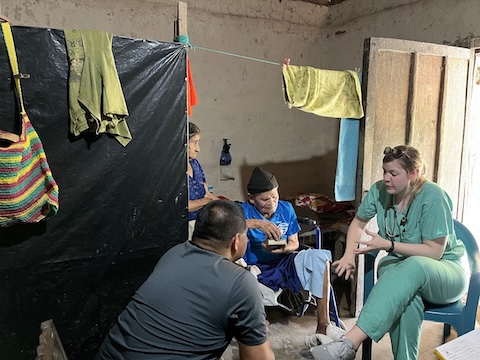Julia Ceglenski, MD: Mountain Area Health Education (MAHEC), Family Medicine- PGY3
Honduras: January 2025

For the past 16 years, my residency program has promoted a strong interest in global health and rural medicine by partnering with an NGO called Shoulder to Shoulder. They help the southwestern area of Intibucá in many ways, but the main aspect of my interaction with their team included participating in a twice-yearly medical brigade with our residency program. Our team during this trip included two supervising family medicine faculty, six family medicine senior residents, a pharmacist, and two psychiatrists. As a brigade, we do our best to align our efforts and integrate with the pre-existing public health system in Honduras. We bring in all our own supplies including weeks’ worth of medications that are available in Honduras, but not always accessible for patients due to cost.
We spent one day working in the central health clinic of Camasca seeing patients and learning from the two local physicians. The rest of our time we drove out to the remote villages surrounding Camasca and set up our own clinic for the day in a school or church. Patients had usually already lined up, and many of the patients would have faced hours of strenuous hiking to reach the health center in Camasca.
There were a wide variety of clinical concerns but many of the most common included hypertension, diabetes, abdominal pain, joint pain, and headache. Our team did our best to meet patients where they were, accounting for the lack of access to resources and follow-up. Some of the most impactful services we provided included physical therapy home exercises, point of care glucose testing, joint injections, and mental health services when applicable.
After a full day of seeing typically 30-50 patients of all ages, we would usually have 2-3 home visits in the afternoon for patients who were too sick or frail to join us at our pop-up clinic. During these visits, we often had to flex our continuity of care muscles as family medicine physicians. Interesting visits included a hospital discharge follow-up for a man who had recently been hospitalized for heart failure, while another was an elderly female who needed to be admitted to the hospital for an infected foot ulcer.
Participating in this brigade helped me fall in love with family medicine all over again and reminded me why I chose this specialty. I really enjoy being able to see patients at all points of their life and across all healthcare settings. Having a glimpse at how another country provides care to their patients was invaluable, and I’m so grateful to have played a small part in their healthcare.